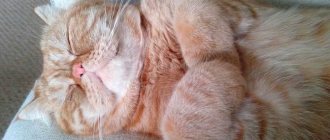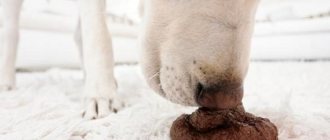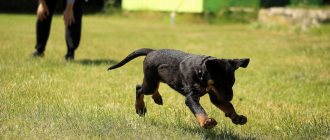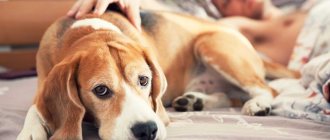If a puppy appears in your home, then you still have many interesting and unexpected discoveries ahead. There are certain patterns in the behavior of dogs that are inherent in all representatives of this species without exception. For example, every dog owner, regardless of its breed, can confidently say that his pet sleeps very restlessly. Why is this happening?
Why does a dog twitch in its sleep?
Movement during sleep is absolutely normal, even for completely healthy dogs with a strong psyche. This is explained simply: the dog also dreams. One can only guess what the four-legged animal is dreaming from by its movements. If it moves its paws, it is probably chasing prey or running away from “enemies.” If she whines, it means she is being offended. Well, if it starts to slurp, it means that it has found something tasty.
In a dream, a dog can:
- lying on your side, move your paws;
- rotate the pupils with closed eyelids;
- move your ears;
- wag the tail;
- make different sounds: whine, bark, growl.
Dogs dream too
However, some movements during sleep may indicate illness in your pet. Therefore, you should carefully look at how he sleeps.
What are the signs of the disease?
Movements during sleep may indicate the presence of pathology. If a dog twitches its whole body in its sleep or experiences convulsions, the owner needs to pay attention to the dog’s behavior during wakefulness. Possible:
- Disorders of the central nervous system. In a dream, the pet pushes strongly with its paws, and after waking up, lethargy and absent-mindedness are observed. Coordination deteriorates during the day.
- Infectious and viral diseases, fever. From an elevated temperature during sleep, the dog will tremble violently and convulsions are possible. The animal is lethargic, the nose is warm and dry, the mucous membranes of the mouth are brighter, thirst increases, and appetite is lost. Possible nausea and stool upset.
- Intoxication. With severe poisoning and further dehydration, convulsions begin. Characteristic symptoms of poisoning are diarrhea, nausea and vomiting, and refusal to eat.
- Pathologies of the cardiovascular system. During the rest period, trembling is observed throughout the body, convulsions are possible, and the heart rate is disturbed. Observe the pet while it is awake, check the color of the mucous membranes, its activity, and whether there is shortness of breath after exercise.
- Overheating of the body. Trembling occurs not only during sleep, but also at other times. Body temperature rises, appetite is lost, thirst increases. The animal is apathetic and moves little.
- Hypothermia. It causes the body to shake, the temperature rises, and if the temperature drops significantly, convulsions begin.
In a dream, an animal can experience an attack of any of the serious diseases. It goes away on its own or requires medical intervention. Signs of a seizure include:
- Obvious excitement. Even if the dog is having a nightmare, you see that he is sleeping, his eyes are closed, his muscles are relaxed. During an attack, the whole body shakes from trembling, the pupils dart.
- Duration of movements. Normally, shudders and paw movements are short-lived. Long shaking is an alarming symptom.
- Impossibility of awakening. During normal sleep, you will call your pet and he will wake up. During a seizure, nothing you do will help.
- The appearance of foam in the mouth, biting the tongue, uneven breathing.
- Vomiting, involuntary bowel movements or urination may occur.
If you don't know how to distinguish natural twitches from involuntary muscle contractions, try waking your dog. During convulsions, he will not wake up, but will be in a deranged state. After calming down, the pet will be tired and will not be able to control its movements. Seizures also occur during wakefulness, especially when the animal is excited.
Leads to seizures:
- heart failure;
- pneumonia;
- epilepsy;
- hormonal disorders, including: hypothyroidism, diabetes, hypoglycemia.
Dog dreams: myth or reality
Scientists answer this question unequivocally: dogs also dream. They began to seriously study this topic back in the middle of the last century, and now this issue has been studied as thoroughly as existing technology allows. It has been proven that, like humans, animals go through several stages of sleep: from light to deep. The latter is characterized by dreams.
A small area of the brain responsible for paralyzing muscles during sleep prevents both people and animals from “participating” in them in full force. It works differently for everyone: someone can sleep absolutely motionless, someone will definitely move. In dogs it is not so well developed, so the vast majority of animals move during sleep.
A dog goes through several stages of sleep: from light to deep.
The first experiments proving the presence of dreams in animals were carried out in the 50s of the last century, and now they would be considered inhumane. They removed part of the brain where the so-called “blue spot” was located.
By the way! The first animal to undergo this operation was a cat.
It is responsible for paralyzing the muscles during sleep. After such an operation, dogs during the deep phase jumped up, ran, played and even began to fight with imaginary enemies.
Interesting! Typically, dogs during such experiments continued to perform their duties during sleep. The hunters pursued the prey or called the owner to it. The guards barked loudly, protecting the territory. The exhibitors stood in a stance allowing one to evaluate their exterior.
Similar experiments are being carried out now, but without surgical intervention. Special medications allow you to temporarily “turn off” part of the brain. After participating in the experiments, the animals return to normal life.
Video - Why does a dog twitch and whine and sometimes bark in its sleep?
No reason to worry
First, let's look at situations where trembling is caused by natural causes that have nothing to do with the dog's health. At the same time, the animal willingly accepts food without refusing it.
Lawless Heart
Similar behavior manifests itself in male dogs during the rut (as well as in females in heat) at the sight of an attractive individual of the opposite sex. It will not lead to convulsive tremor, although this happens in some particularly emotional small breeds. If the dog is shaking with small tremors for this very reason, and you don’t like it, the problem can be solved by castration or sterilization of the animal.
- I’m kind of sad.
Dog cold
The feeling of cold causes dogs to shake and tuck their tails. As a rule, this applies to small smooth-haired breeds. It is for such cases that various dog overalls are invented. To prevent a cold, it is better to cover your tailed pet with a warm blanket, wear a cozy sweater, or increase the temperature in the room. The same applies to freshly washed dogs.
Emotions run high
Trembling can also be caused by the manifestation of strong emotions, for example, excitement - when moving or in anticipation of a portion of your favorite food. Dogs often shake with delight when their beloved owner returns after a long absence. If your pet is shaking in his sleep, don't worry - he's just dreaming about something pleasant. The same reaction can be caused by the sound of thunder or the loud pop of a faulty muffler on the street.
Why is the dog shaking as if he has a chill if none of the above has happened?
How do dogs' dreams differ from human dreams?
With the advent of technology that allows one to monitor brain activity during sleep, experiments on dogs were continued. With their help, it was possible to prove that dog dreams are different from human dreams. They are brighter, more dynamic, and quickly replace each other. Thus, the deep sleep phase in a person can last about one and a half hours. During this time, he manages to view the whole story. In dogs, it takes on average 20-25 minutes, and the dream consists of 2-3 pictures that quickly replace each other.
Interesting! In small breeds of dogs, sleep phases alternate more often than in adults. So, in a toy terrier this can happen every 10 minutes, in a Great Dane - every hour.
Scientists are also inclined to believe that during sleep, animals can not only see and hear, but also smell. This is evidenced by the fact that they often twitch their nose in their sleep, as if sniffing at something.
In small breeds of dogs, sleep phases alternate more often than in adults
Psycho-emotional factors
Some dogs greet their owners and whine to express joy and excitement.
Plaintive whining is a wonderful way of manipulation. It is enough to once get what you want in such a way that you remember and draw conclusions - the owner will not be able to resist, will be indignant, but will give something tasty.
Inability to achieve what you want. Birds are chirping outside the window, and the neighbor’s cat is lying brazenly on the grass. And everything seems to be nearby, and close, but the door is locked. It’s not just whining, you can howl with frustration.
By whining, a dog can convey strong emotions: excitement, fear, disappointment. If this has not happened before, it is worth analyzing recent events. Concern can be caused by moving, having a child, a new animal, and even renovations for neighbors 3 floors above.
What do animals dream about?
So far no one has been able to “spy” on the dreams of animals. However, scientists have reason to believe that they are more diverse than we might imagine. Definitely, often a dream is a reflection of what has been experienced. Therefore, the central part of the plot is usually the owner, who is the center of the universe for the dog. Often dogs in which the “blue spot” was neutralized, in the active phase of sleep, did everything the same as during the day: played, followed commands, ran.
However, studies have shown that it is during sleep that ancient instincts manifest themselves in animals. Thus, even trained dogs, whose ancestors served humans for many generations, can begin to howl like wolves during the deep phase. And under the influence of drugs, they completely demonstrated original behavior: even decorative dogs could “go hunting” and demonstrate behavior characteristic of their ancestors in the pack.
During sleep, ancient instincts appear in an animal
Circling in place and digging
Another strange behavior you may have observed when your dog is getting ready for bed is the habit of scratching the floor and spinning in place before lying down, even on a soft surface such as a bed or pillow. This behavior is rooted in the same nesting instinct that causes dogs to curl up. In the wild, their canine ancestors dug into the ground to soften it and create a sleeping den that provided them with extra protection and helped regulate their body temperature. They would also spin in place to compact earth, leaves, or grass mat on their bed to make it more comfortable. Why this instinct has survived for thousands of years and is still strong in domestic animals remains a mystery.
Do dogs have nightmares?
Fears are often reflected in dreams, including those of dogs. It is not difficult to understand that a dog is seeing a “bad” dream. In this case, the pet will whine, tuck its tail, desperately pound its paws and demonstrate anxiety in all sorts of other ways.
If such cases are isolated, you may not attach much importance to this. However, after severe stress, nightmares may recur. This is a signal to the owner that the animal feels insecure, and can subsequently result in health problems.
You can calm the animal by following simple rules:
- praise him more often, stroke him, talk, play;
- increase the time for an evening walk, but do not start active games and running around;
- Give mild sedatives to dogs.
Fears are often reflected in dog dreams
Therefore, a dog's whining does not automatically mean something bad.
So why do dogs moan? It all comes down to context. As mentioned earlier, dog moaning occurs for a variety of reasons. The key to differentiating these different causes of whining dogs is context.
“Your dog can whine for many reasons,” says Dr. Dilmore. "You may have to investigate and see if it is caused by any of these factors."
"If you notice any changes in your dog's vocal behavior or if you are concerned about his health, you should take him to the vet," says Dr. Dilmore.
Should you wake your dog during deep sleep?
Waking up in the stage of light sleep, the dog does not remember what it dreamed. However, if you wake her up during the deep stage, she will not immediately wake up from sleep. Most likely, in this case, you will look around for several seconds, as if not understanding where you are.
However, such an awakening can also be dangerous. A dog that “chased” enemies in a dream may growl, snap, or even bite its owner. This does not indicate hidden aggression, but only proves that in a dream, pets remember their instincts.
If nervous twitching and whining bother the owner, you can wake up the dog. However, you should not touch it. It's much safer to call her by name.
How not to lose sight of the disease?
You need to be able to distinguish cramps from natural twitching during sleep. When in doubt, wake up the dog. A pet who feels well will quickly regain consciousness; you will not be able to influence the seizures without medication. Do you notice that your pet feels unwell after waking up, drops its head, cannot swallow saliva completely, or has difficulty getting to its feet? Contact your doctor and don't delay. Severe weakness indicates a previous seizure , which may have stopped when you suddenly spoke loudly to the dog or pushed it to the side in an attempt to wake it up.
Important! If your dog gets up or jumps up and runs in his sleep, you need to analyze the level of stress that the pet is experiencing. Small twitches are normal, but strong paw kicks indicate a disturbance in the central nervous system.
Dreams of puppies
Research has also shown that dogs have their first dreams while still in the womb. Therefore, it is not surprising that newborns can squeak and move in their sleep.
Dogs begin to have their first dreams while still in the womb
Puppy dreams last longer than in adult dogs. The active phase can take up to 90% of their sleep time. In addition, the children’s nervous system has not strengthened, so they may react more violently to dreams. They often begin to bark and whine, thereby waking themselves up.
In cases of such an “emergency” awakening, they may behave inappropriately for a few seconds: look around, not understanding where they are, continue whining, or even jump up sharply and run.
Interesting! Puppies can sleep with their eyes open. In this case, the pupils are covered with a thin film - the third eyelid.
This behavior worsens when moving to a new home. This is a lot of stress for the puppy, so the owner will have to show maximum understanding and patience while waiting for the puppy to adapt. Once this happens, his sleep will become more restful.











